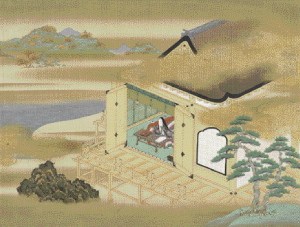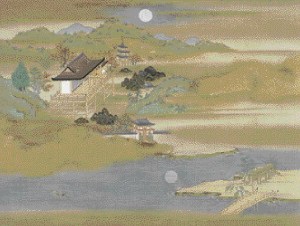The Japanese woman who wrote the extraordinary Tale of Genji a thousand years ago is known only by a nickname. Her given name went unrecorded, which was normal for a daughter. Shikibu, which means "Bureau of Ceremonial," refers to a post once held by her father, and Murasaki, the name of a plant that produces a purple dyestuff, is her tale's main heroine.
Our Murasaki was born into a lesser branch of the powerful Fujiwara family, whose males occupied most of the highest positions in the imperial government. The greatest might rule as regent or marry a daughter to the emperor and have an imperial grandson. Murasaki's father, however, was only a scholar and a provincial governor who served in Harima, Echigo, and Echizen, to which his daughter accompanied him in 996. Liza Dalby's fictional autobiography, The Tale of Murasaki, gives her a romantic adventure there, on the coast of the Sea of Japan, with one of the Chinese merchants who sometimes visited.


| These paintings by the seventeenth-century artist Tosa Mitsuoki frame a set of 54 album leaf paintings done by Tosa Mitsunobu about 1510. Paintings courtesy of the Arthur M. Sackler Museum, Harvard University Art Museums, bequest of the Hofer Collection of the Arts of Asia ©President and Fellows of Harvard College. Photographs by Peter Siegel |
Murasaki married in 998 or 999, but lost her husband in 1001. Her daughter, probably born in 999, became a distinguished poet. About 1006, Murasaki was called to serve the empress, no doubt because of her talent for writing stories. She last appears in a record dating from 1013, and may have died the following year. Apart from The Tale of Genji she left a collection of her poetry and a fragmentary diary devoted largely to events at the palace in 1008. She does mention that she learned Chinese by listening outside the door while her father taught her brother, and that later she gave the empress lessons in reading Chinese poetry.
In her time, court ladies were expected to confine themselves to stories written in Japanese. Such frivolities were supposedly beneath men's notice, yet her hero declares in one chapter, "Without stories like these about the old days, though, how would we ever pass the time when there is nothing else to do? Besides, among these lies there certainly are some plausibly touching scenes, convincingly told....We may disbelieve the blatantly impossible but still be amazed by magnificently contrived wonders...." Her own story, centered on the life of the "shining prince," Genji, evoked for her contemporaries a version of their world in which many things are done right for a change. Even so, life's cruelties show clearly enough through the grace of color and form; the author saw things very clearly.
No one knows just when she began her tale or when she finished it, but her diary suggests that whatever existed in 1007 or 1008 was hers, and she has been recognized ever since as the author of all 54 chapters. The chapters, however, do not all seem to have been written in their present order. The tale contains some astonishing writing, but it also suggests brilliant editing. Does it have a consciously planned structure? Many doubt that it does, apart from the loose continuity of time as the characters age, but others (like me) see a more concerted design. The question is one for each reader to decide.
A book-length, fourteenth-century commentary on the tale relates that a certain princess once asked the empress whether she had any new stories. Having none to offer, the empress asked Murasaki Shikibu to write one. The lady therefore went on pilgrimage to Ishiyama-dera, a temple near the southern end of Lake Biwa, a day's journey by ox carriage east of Kyoto, in search of inspiration. According to legend, Murasaki had been close since childhood to a gifted courtier unjustly exiled to Kyushu. That night at the temple, the full moon of the eighth lunar month shone up from the lake's waters, and while she lost herself in its beauty a vision of the tale rose before her. She saw her hero, Genji, languishing in unjust exile on the shore of a moonlit sea, and the image was so compelling that, lest she forget it, she immediately wrote down what became chapters 11 and 12. After that, the legend says, she simply added the others until she had 54 in all.
The artist Tosa Mitsuoki's evocation of the legend has a simple grandeur. In his first painting, the author sits before a writing desk at Ishiyama-dera, gazing out through open, double doors at a broad scene of lake and hills; in the second, a full moon soars over the hills as its reflection shines up from the lake. The two works frame 54 others, each illustrating a chapter of the tale, as though his Murasaki contemplates through the chapters the moon from which her vision and insight issue, and to which they return.
Hers is certainly a most remarkable tale. After eight and a half years spent translating, pondering, and discussing it, I still cannot imagine how she created it. The gist of a passage Montaigne wrote in praise of Homer applies equally well to Murasaki Shikibu.
It is against nature that he made the most excellent creation that could ever be; for things are normally born imperfect, then grow and gather strength as they do so. He took poetry and several other sciences in their infancy and brought them to perfect, accomplished maturity. [Thus] one may call him the first and last of poets, in accordance with that fine tribute left to us by antiquity: that, having had no predecessor to imitate, he had no successor capable of imitating him.
Similarly, nothing earlier announces The Tale of Genji, and nothing came close to it again.
Royall Tyler '57 is a visiting professor of Japanese at Harvard. His new translation of The Tale of Genji was published by Viking late last year.





